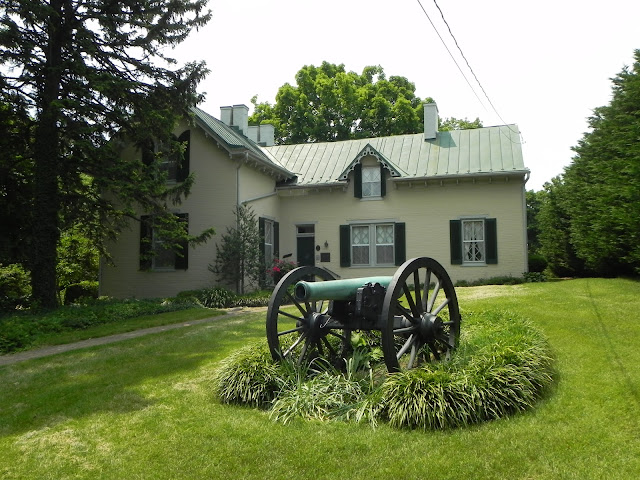Winchester has a long and remarkable history dating to colonial times. Names like Stonewall Jackson and George Washington loom large. During the Civil War, Winchester occupied a strategic location at the northern end of the agriculturally rich Shenandoah Valley. Both Union and Confederate armies viewed Winchester as a gateway for invasion and attack. Not surprisingly, the war had a dramatic impact on the town and its citizens. The Winchester area witnessed six major battles between 1862-64, and the town allegedly changed hands over seventy times throughout the war.
My friend and I arrived in Winchester about noon on a Saturday. After the requisite stop at the Visitor Center, we headed to the Old Court House Civil War Museum, which is located in the former Frederick County Courthouse. The building was constructed in 1840 and served as a courthouse until 1984. During the Civil War, the courthouse was used by both Union and Confederate forces as a hospital and prison. Some of the graffiti left behind by prisoners is still visible on the courthouse walls.
The "old school" museum upstairs contains a truly dizzying array of Civil War artifacts. The entire second floor is filled with display cases of buttons, belt buckles, weapons, corps badges, bayonets, artillery shells, and other objects. The museum has interpreted each artifact in minute detail. I'd recommend a stop at the museum, but if you are really into this sort of thing, be forewarned that you could spend hours looking at the displays.
 |
| The old Frederick County Courthouse at 20 N. Loudoun St., now the site of a Civil War museum housing an extensive collection of artifacts from the conflict. |
self-guided walking tour of Civil War Winchester published by Preservation of Historic Winchester. He brought the brochure along, and we followed the tour as we explored Old Town. A few of the notable homes included Philip Sheridan's Headquarters and the house where Jackson and his wife stayed during the first winter of the war. The walking tour is a must-do for those seeking to understand fully Winchester's role in the Civil War.
Stonewall Jackson's Headquarters. At the time of the war, the house belonged to Lt. Col. Lewis T. Moore of the 4th Virginia. Moore, who was convalescing in Richmond, invited Jackson to use his home as headquarters while Jackson was serving as head of the Valley District. Jackson worked there from November 1861 to March 1862. He also resided in the Moore home for part of the time, until moving into the Graham home picture above.
The museum tour guide provided an overview of Jackson's life and explained many of the historic objects on display in the rooms of the house. I was pleasantly surprised that the tour steered clear of overblown, Lost Cause-style rhetoric about Jackson. The house contains a multitude of Jackson's personal belongings, including his prayer book, camp chest, quilt, and desk. The museum touts the display as "the largest collection of Jackson memorabilia." And I suppose they are right. Where else can you see the sculptor's model of that Stonewall-on-steroids statue located on the Manassas Battlefield? The museum also displays artifacts from others who served with Jackson. I particularly enjoyed seeing Turner Ashby's saddle and William Pendleton's camp chest.
George Washington's Office, which dates to the time of the French & Indian War. Perhaps unknown to many readers, I am also an enthusiast of this early American conflict, which has a strong connection to my hometown of Pittsburgh. For anyone interested in colonial history, I can't say enough about this site. Part of the structure served as Washington's office in Winchester while he supervised the construction of Fort Loudoun on the north side of the town between September 1755 and December 1756. At the time, Washington was serving as the colonel of the Virginia Regiment. The museum contains a number of fascinating exhibits about the early history of Winchester and Washington's time there. Visitors are bound to pick some interesting tidbits about the area during the French & Indian War. Even if you've come to Winchester mainly for the Civil War history, don't miss this place.
 |
| George Washington's Office at 32 West Cork & Braddock Streets. The log cabin where Washington had his office is now at the center of this building. |
Up Next
In the next installment, I'll examine Winchester's Civil War cemeteries and take readers on a tour of First Winchester (what's left of it) and Kernstown.
Information and Sources
Aside from the links provided above, the following websites are useful for planning a trip to Winchester:
1) Winchester-Frederick County Visitor Center
2) Old Town Winchester
I picked up a copy of Civil War Winchester by Jerry W. Holsworth to learn more about the war in this pivotal Shenandoah Valley town.




No comments:
Post a Comment